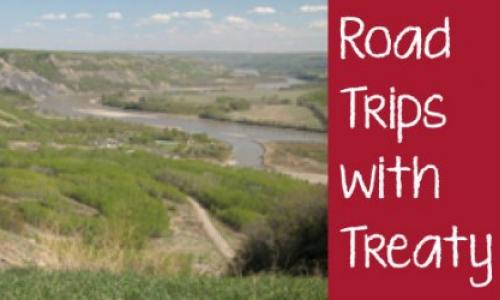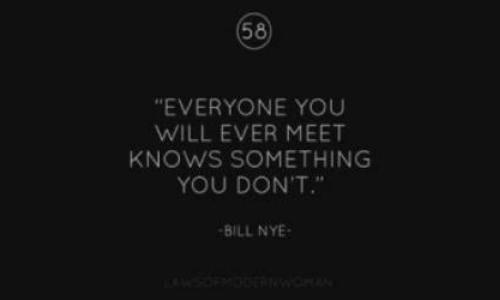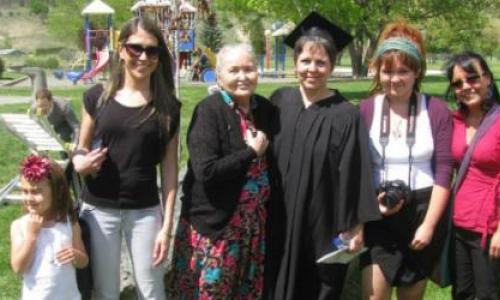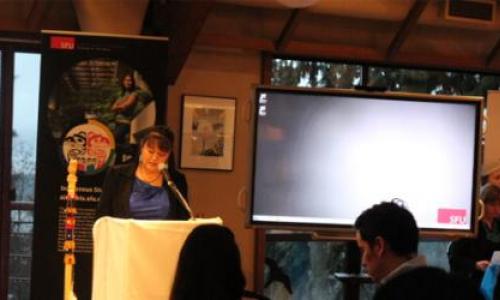"The Grandmother in this book, like Rusty, is a composite of a number of old Native women I have known. Their lives, likewise, are a composite of the reality of our history and present existence. Their feelings about life are my own. Their teachings are ac cent and as closely accounted for as I can remember."
“If you live right the grandmothers will take care of you,”
- Maracle, 1996, p. 6
I begin with the grandmothers because as I continue on in my journey learning the teachings of my grandmother and learning the stories of my mother, grandmother and the grandmothers who came before, I have found a tremendous amount of strength, of power, and of responsibility. Lee Maracle’s, I Am Woman (1996), has inspired a generation of women, and is now coming to inspire the next generation. What struck me first and foremost was her ferocity and ‘no-holds-barred’ way of writing and communicating her ideas. She speaks of the grandmothers and our responsibility to learn from them, which is why my work is based on my own grandmothers teachings, to which I have come to feel fiercely protective.
The book itself is filled with intellectual accounts of feminism and all thats associated with it, such as; love, sex, lesbianism, settler women’s ideas, the native elite, laws and traditionalism, rape, pregnancy, abuse, abandonment, death, suicide, violence, institutionalization, teachers, assimilation, ideologies in education, resistance, the American Indian Movement, Marxism, communism, science and Native medicine, corporations, consumerism, exploitation, spirituality, teaching our daughters and racism. That is a long list of concepts and ideas, all of which come back to discussing the Native woman’s experience. Her inclusion of stories of Rusty, a woman friend that ultimately took her own life is included, as well as, Maracle’s poetry that is scattered throughout the chapters. The book weaves both intellectual and creative thought, that acts as resistance to the colonial powers that be.
As I was drawn into the devastating honesty to which Maracle is known for, I was hyper aware of my own experiences, particularly associated with sexual assault in the home, which is so common amongst Native communities.
Rape, ladies and gentlemen, is commonplace in the home. In the home, it is not a crime. What is worse, in our desperate fear of being unloved, a good many women plead for mercy and accept responsibility for the beating and beg forgiveness for imaginary transgressions. Could this be where men get the idea that women “like it, ask for it” when the subject of rape is discussed? (Maracle, 1996, p. 23).
While my experiences with assault are slightly different, they evoke the same powerlessness, the same desperate need for love. These experiences that Maracle writes about so poignantly, are the experiences of my mother and grandmothers; my aunties and cousins.
Though, most of I Am Woman is filled with the hard truths of Native life that a large portion of settler population chooses to ignore and deny, I was moved by the sections of the book that discussed spirituality, resistance and a connection to culture and self. The confusion associated with my mixed heritage, my pale skin and my adoption into Tsleil-Waututh has made it difficult for me to know exactly who I am as an individual and as a community member. The aspects of spirituality from both the Tsleil-Waututh people, as well as to my Grandmother’s Cree heritage, have allowed me to sift through the confusion and lateral violence and own my place in the arms of my grandmothers. This, in and of itself, is my own act of resistance and decolonization.
Spirituality is re-connecting with the self and our ancestry. It is doing the right thing for your family and your community. Burn sage, brothers and sisters, but when you are burning it and carrying a small child, think about going to school and fighting red-neck teachers, the nicest of whom is going to ask you to erase yourself and be like him. Our kids need to know that are on their side. (Maracle, 1996, p. 134).
Maracle’s book is an inspiring tale of the Native experience, and one that connected me to why I am doing this work; why I am attempting to bring alternative pedagogies into colonial institutions. The reason is so that we, as Indigenous people, might have the opportunity to teach the white settler that we are here, we are visible and we have a real and valid way of life that has the potential to heal the land its people.
Bermuda Triangle-by Christina Coolidge
I don't know how not to bring all of me with me everywhere I go. Everything that has ever happened to me is in here, in this chest, in this body.
Without me, it doesn't exist.
Without it, I don’t exist.
Every person, every moment, every hurt, every joy, every trauma, every conversation inside me, and I bring it with me into every interaction.
With every breath, I am breathing the moments of my life, again and again and again.
Every touch, every heartbeat, every shared moment of friendship, of laughter, of love
you are here in this space where God lives, where my breath becomes life.
How do I not take that with me? and how do you not also take me with you?
We live as if hearts can be mended.
We live as if we'll live forever.
We live as if nothing is a miracle and when we lay our head down to die, we regret having missed so many things, we wonder where the time went.
I live it and breathe it and feel it every day.
All of my life, for as long as I can remember, my blessing and my curse
Poets and artists and dreamers speak of pain. pain as pure as joy.
in the beat of the heart at night, surrounded by ghosts and shadows and all things unholy.
The pain of a thousand lifetimes, the pain of every lost opportunity for kindness or love, the pain of every crumple or tear in the dress worn by the little girl inside, who looks for something, someone, to tell her she is okay. To tell her she is lovely and worthy and whole, but no one does and she can’t hear it anyway.
The fiery wings of something magnificent
a phantom, and this woman rides on its back.
this woman who carries her ferocity and vitality and charisma on the soles of her feet because to see it, to look straight at it, would make men fall to their knees and weep at the power in the flecks of gold in her eyes.
this capacity for strength and courage and honesty and love
is met always and equally with this capacity for
weakness and cowardice and dishonesty and fear.
to make sense of all that i am and all that i’ve lived and all that i feel is impossible and too exhausting to consider.
we, each of us, has a million tiny universes swirling inside our consciousness, every second of the day and we wonder why we’re tired.
We wonder why we work too much or drink too much, escaping all that seeks our time or attention or our hearts.
To look into the darkness, to see it and feel it is too terrifying to fathom, like the bermuda triangle or something.
To feel so deeply and to know who you are when I look at you and knowing that you don’t see what i see is the greatest tragedy of all.
its as if you’ve forgotten everything.















